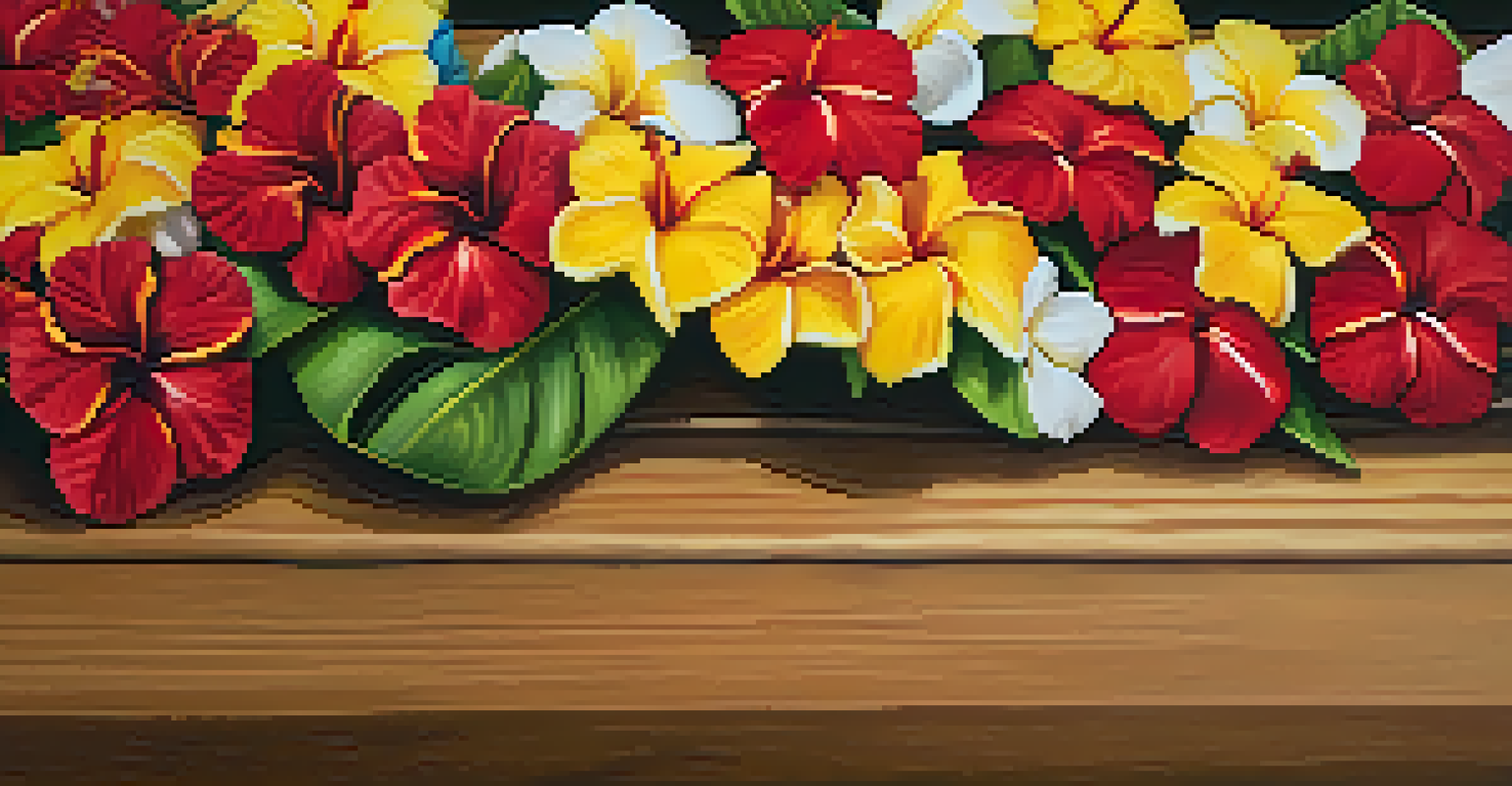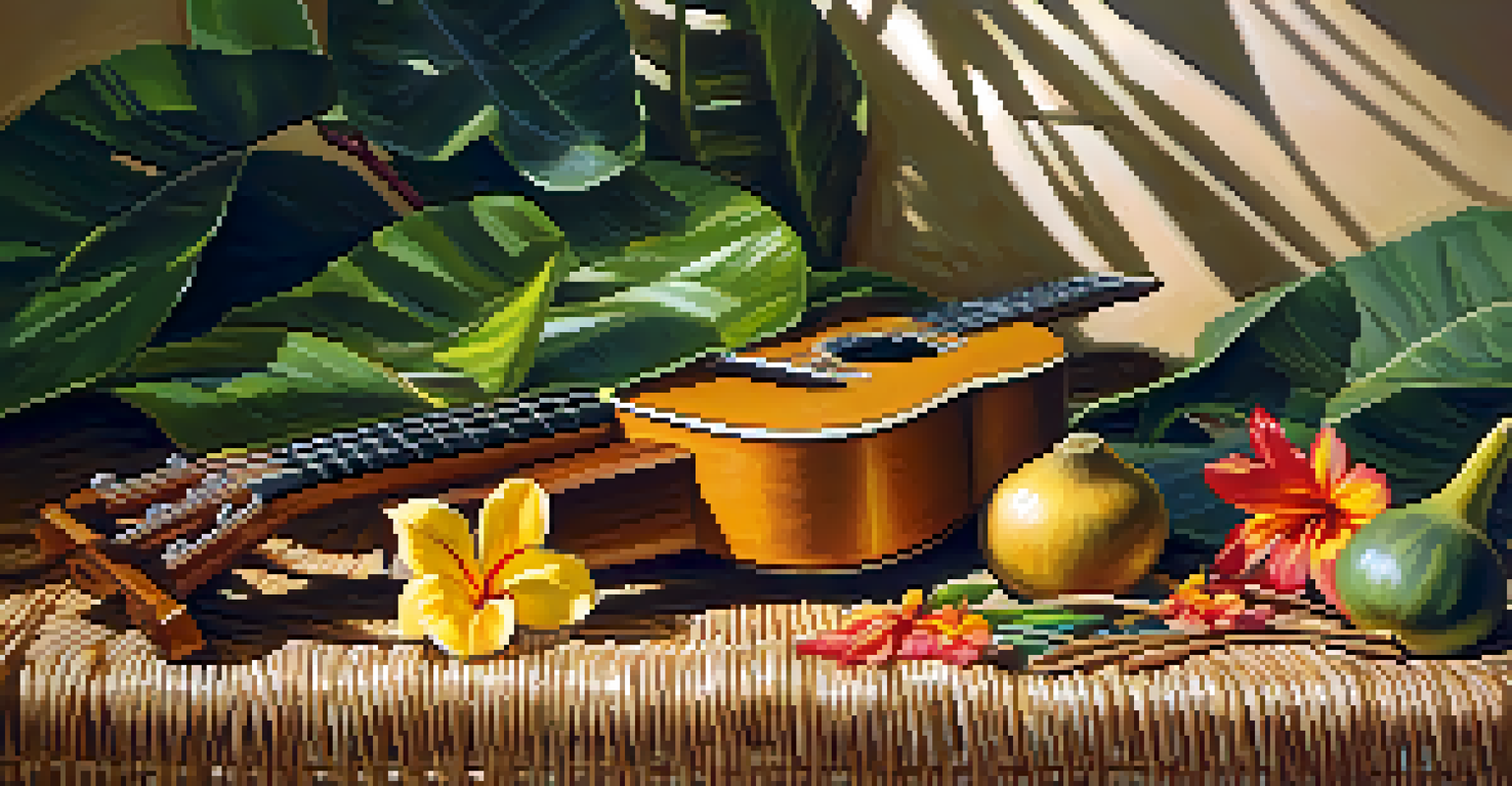Hawaii's Merrie Monarch Festival: A Celebration of Hula and Flora

The Origins of Merrie Monarch Festival
The Merrie Monarch Festival, established in 1964, is a tribute to King David Kalakaua, known as the Merrie Monarch himself. This festival not only celebrates hula but also aims to preserve Hawaiian culture and arts. Its inception was a response to the declining interest in Hawaiian traditions, and it has since blossomed into a vibrant annual event.
Hula is the language of the heart and the soul.
Taking place in Hilo, Hawaii, the festival attracts thousands of visitors who come to witness stunning hula performances and cultural exhibitions. Each year, the event grows, drawing participants from around the world who share a love for Hawaiian culture. The festival showcases the beauty of hula as a storytelling medium deeply rooted in Hawaiian history.
Moreover, the festival has become a platform for cultural exchange, allowing both locals and visitors to appreciate the richness of Hawaiian heritage. In essence, the Merrie Monarch Festival serves as a reminder of the importance of preserving cultural identity in an ever-changing world.
The Heart of Hula: Dance and Expression
Hula is more than just a dance; it's a form of storytelling that conveys the history, values, and emotions of the Hawaiian people. Each movement in hula has a specific meaning, often reflecting the beauty of nature, mythology, or everyday life. Dancers use their bodies to express stories, connecting both the performer and the audience to the spirit of Hawaii.

The festival features various hula competitions, showcasing different styles such as hula kahiko, the ancient form, and hula 'auana, the modern style. Each performance is a tribute to the hard work and dedication of dancers who train for years to perfect their craft. This dedication is evident as they bring stories to life through rhythm, chants, and graceful movements.
Cultural Celebration through Hula
The Merrie Monarch Festival celebrates and preserves Hawaiian culture through vibrant hula performances and cultural exchanges.
Hula also serves to strengthen community bonds, as families often participate together, passing down traditions through generations. This intergenerational connection enriches the cultural tapestry of Hawaii and reminds us that dance is not just an art form but a vital part of the island's identity.
Flora: The Natural Beauty of Hawaii
Hawaii's lush landscape is an integral part of the Merrie Monarch Festival, as many performances incorporate elements of the island's flora. Dancers often adorn themselves with beautiful lei, skirts, and accessories made from native plants, signifying the deep connection between the land and its people. This use of nature in hula not only enhances the visual experience but also pays homage to the environment that nurtures cultural practices.
To preserve the culture is to preserve the spirit of the land.
The variety of flowers and plants used in hula costumes showcases the incredible biodiversity of Hawaii. From vibrant hibiscus and fragrant plumeria to delicate ti leaves, each plant has its own significance and beauty. This connection to flora is a reminder that the stories told through dance are intertwined with the natural world around us.
Moreover, the festival highlights the importance of environmental stewardship, encouraging attendees to appreciate and protect Hawaii's unique ecosystems. By showcasing the beauty of native plants, the Merrie Monarch Festival fosters a greater understanding of how flora and culture coexist harmoniously.
Cultural Workshops and Community Engagement
A significant aspect of the Merrie Monarch Festival is the opportunity for attendees to participate in workshops that delve into various Hawaiian traditions. These workshops cover everything from hula and lei-making to the art of Hawaiian chant (oli). They provide a hands-on experience for visitors to connect with the culture on a deeper level.
Community engagement is at the heart of the festival, with local schools and organizations actively involved in planning and executing events. This collaboration fosters a sense of pride among residents, as they showcase their heritage to the world. It also creates a welcoming environment where visitors can learn and appreciate Hawaiian customs.
Community Engagement and Workshops
The festival fosters community involvement by offering workshops that allow attendees to engage with traditional Hawaiian arts and practices.
Through these workshops, the festival emphasizes the importance of cultural preservation and education. By inviting everyone to participate, the Merrie Monarch Festival ensures that the spirit of hula and Hawaiian traditions continue to thrive for generations to come.
The Role of Music in Hula Performances
Music is the heartbeat of hula, providing rhythm and emotion that enhance each dance. Traditional Hawaiian instruments like the ukulele, pahu (drum), and ipu (gourd) create a unique soundscape that accompanies hula performances. This musical backdrop sets the stage for storytelling, allowing dancers to express their narratives more vividly.
The chants, known as mele, are integral to hula, often recounting historical events, legends, or the beauty of nature. These poetic expressions not only enrich the performance but also serve as a means of preserving the Hawaiian language. As dancers move to the rhythm, they embody the essence of the stories being told, making each performance a living tribute to their culture.
The festival features live music during competitions, further enhancing the experience for both performers and spectators. The interplay between dance and music creates an atmosphere of celebration, where the audience is invited to feel the spirit of Hawaii through each beat and movement.
Celebrating Hawaiian Values Through the Festival
The Merrie Monarch Festival embodies essential Hawaiian values such as aloha (love), kuleana (responsibility), and malama (to care for). These principles are woven into the fabric of the festival, reminding participants and attendees of their significance in everyday life. The celebration fosters a sense of unity, encouraging individuals to embrace these values within their communities.
Through performances and workshops, the festival teaches the importance of respect for culture and heritage. It serves as a platform for sharing stories that reflect the resilience and spirit of the Hawaiian people. Each event is a celebration of identity, emphasizing that understanding and appreciating one’s roots is vital for personal and communal growth.
Sustainability and Environmental Care
By highlighting native flora and promoting environmental stewardship, the festival emphasizes the importance of caring for Hawaii's unique ecosystems.
Additionally, the festival promotes sustainability and environmental consciousness, encouraging attendees to be responsible stewards of the land. By celebrating these values, the Merrie Monarch Festival not only entertains but also inspires a deeper connection to Hawaiian culture and the environment.
The Future of the Merrie Monarch Festival
As the Merrie Monarch Festival continues to grow, its future remains bright with opportunities for innovation and cultural exchange. The festival has embraced modern technology, allowing virtual participation and expanding its reach to a global audience. This adaptation ensures that the spirit of hula and Hawaiian culture can be shared far beyond the shores of Hawaii.
Furthermore, as younger generations become involved in both performance and organization, the festival will likely evolve while staying true to its roots. This infusion of fresh ideas and perspectives will help keep traditions alive and relevant in an ever-changing world. The involvement of youth emphasizes the importance of cultural transmission and the need to adapt to contemporary contexts.

Ultimately, the Merrie Monarch Festival stands as a beacon of hope for cultural preservation and celebration. With its commitment to honoring the past while welcoming the future, this festival will continue to unite people in appreciation of hula, flora, and the rich heritage of Hawaii.